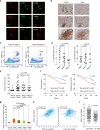Single-cell transcriptome and antigen-immunoglobin analysis reveals the diversity of B cells in non-small cell lung cancer
- PMID: 32580738
- PMCID: PMC7315523
- DOI: 10.1186/s13059-020-02064-6
Single-cell transcriptome and antigen-immunoglobin analysis reveals the diversity of B cells in non-small cell lung cancer
Abstract
Background: Malignant transformation and progression of cancer are driven by the co-evolution of cancer cells and their dysregulated tumor microenvironment (TME). Recent studies on immunotherapy demonstrate the efficacy in reverting the anti-tumoral function of T cells, highlighting the therapeutic potential in targeting certain cell types in TME. However, the functions of other immune cell types remain largely unexplored.
Results: We conduct a single-cell RNA-seq analysis of cells isolated from tumor tissue samples of non-small cell lung cancer (NSCLC) patients, and identify subtypes of tumor-infiltrated B cells and their diverse functions in the progression of NSCLC. Flow cytometry and immunohistochemistry experiments on two independent cohorts confirm the co-existence of the two major subtypes of B cells, namely the naïve-like and plasma-like B cells. The naïve-like B cells are decreased in advanced NSCLC, and their lower level is associated with poor prognosis. Co-culture of isolated naïve-like B cells from NSCLC patients with two lung cancer cell lines demonstrate that the naïve-like B cells suppress the growth of lung cancer cells by secreting four factors negatively regulating the cell growth. We also demonstrate that the plasma-like B cells inhibit cancer cell growth in the early stage of NSCLC, but promote cell growth in the advanced stage of NSCLC. The roles of the plasma-like B cell produced immunoglobulins, and their interacting proteins in the progression of NSCLC are further validated by proteomics data.
Conclusion: Our analysis reveals versatile functions of tumor-infiltrating B cells and their potential clinical implications in NSCLC.
Conflict of interest statement
The authors declare no competing interests.
Figures






References
-
- Herbst RS, Morgensztern D, Boshoff C. The biology and management of non-small cell lung cancer. Nature. 2018;553:446–454. - PubMed
-
- Singal G, Miller PG, Agarwala V, Li G, Kaushik G, Backenroth D, Gossai A, Frampton GM, Torres AZ, Lehnert EM, et al. Association of patient characteristics and tumor genomics with clinical outcomes among patients with non-small cell lung cancer using a clinicogenomic database. JAMA. 2019;321:1391–1399. - PMC - PubMed
Publication types
MeSH terms
Substances
LinkOut - more resources
Full Text Sources
Other Literature Sources
Medical

